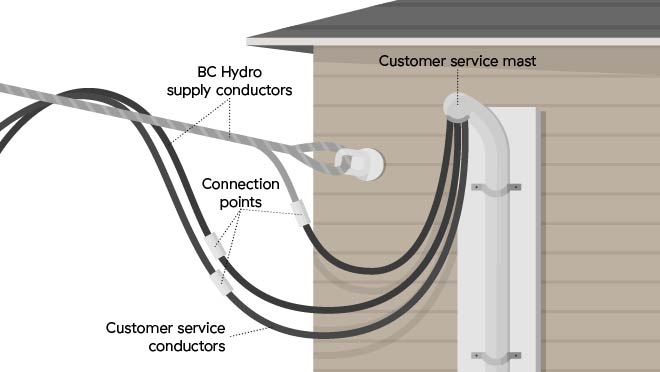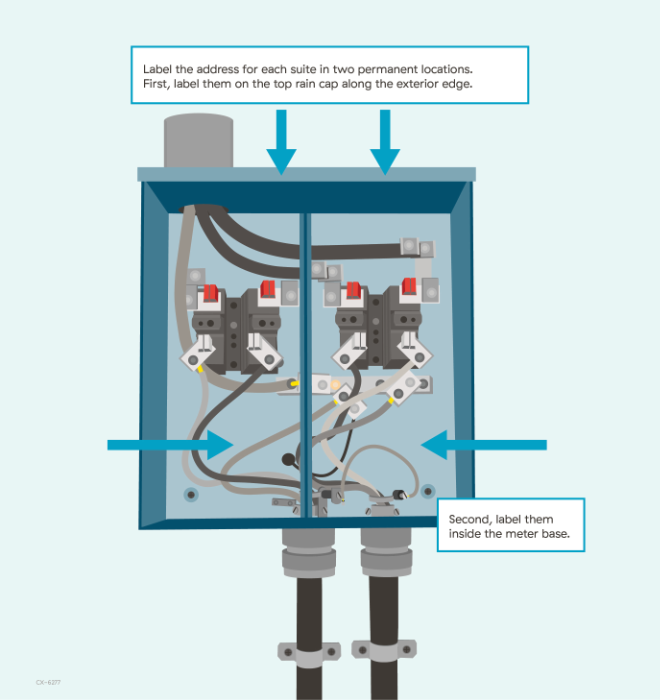Overhead and underground connection requirements
New connections and modifications to existing overhead and underground connections must meet our requirements to ensure safety. Prior to construction, please review the overhead and underground service reference guides which outline our requirements in order to avoid delays and call back charges associated with non-conforming installations.
Questions can be directed to our Express Connect team from Monday to Friday between 8 a.m. and 4 p.m. at 1 877 520 1355.
If crews can't proceed with the request because the installation does not meet BC Hydro requirements, service will be rejected and call back charges will be applied.

Service height
The point of attachment must be within 7 metres above the ground.
The clearance of supply conductors at any point above the ground must be to the follow specifications:
Across highways, freeways and expressways: 7.1 m
- Across streets, lanes, alleys and pipeline right-of-way: 5.5 m
- Across driveways to commercial and industrial premises: 5.5 m
- Across driveways to residential garages: 4.5 m
- Across ground normally accessible to pedestrians only: 3.5 m
Adequate clearance for safe use of a ladder by our installers (1 m from wall for every 4 m in height) must be available to meet BC Hydro and WorkSafe BC regulations.
Learn more about ladder safety requirements.
Service location
The location of the service entrance (wire holder) must not create an aerial trespass and shall be:
- In direct line of sight with BC Hydro's service pole
- On the wall of the building facing the power supply; or
- No further than 1 m (3 ft) back, on the side of the building closest to BC Hydro's source or stub off
If a roof mast is required to meet the minimum vertical clearance above grade, it must be located within 45 centimetres (18 in) from the edge of the roof within reach of the installer's ladder. Rain gutters must be reinforced to be capable of holding the weight of an installer on a ladder without damaging the gutter.
We recommend that ducts for the utility supply service conductors are installed outside of the building wall or the ducts must be encased in concrete. This is in accordance with the BC Electrical Code administered by BC Safety Authority or the local safety inspection branch.
Customer-owned poles with utility services must be accessible by a bucket truck with a relatively even and drivable surface, and be within 3 meters of a lane or roadway.
Mid-span taps are normally not allowed. If you can't meet the requirements of the preferred service location, please contact the Express Connect team from Monday to Friday between 8 a.m. and 4 p.m. at 1 877 520 1355.
Service length
The maximum service length from a BC Hydro pole to the customer's point of attachment is 30 metres (100 feet). If the service length exceeds 30 metres, an intermediate pole may be required.
Meters
- Residential meters must be accessible to BC Hydro representatives at all times
- Meters must not be installed inside carports, garages or breezeways, or in any part of a structure that may potentially be enclosed or within 1 metre of a natural gas relief discharge device or vent, or 3 within metres of a propane gasrelief discharge device or vent
- Meters must be installed between 1.5 and 1.8 metres (5 and 6 feet) above finished grade
- The meter base is not more than 1 metre (3 feet) from the corner of the building closest to BC Hydro's source
- If the site has multiple meter bases, each must be clearly labelled (e.g. "House" and "Suite", or "Suite 1" and "Suite 2"), using a durable paint pen in permanent, non-removable locations. This practice is an addition to the electrical code standards and must be performed by qualified personnel on de-energized equipment. Not labelling multiple meter bases may result in delays and additional charges for return trips to the site.

Safety and ladder use
If crews need a ladder to reach the service entrance:
- The ladder ratio (4 metres high to 1 metre across) is met when the ladder is up against the building, without creating an aerial trespass over a neighbour's property
- The roof mast is located within 45 centimetres (18 inches) from the edge of the roof within reach of the installer's ladder
- Stairs do not interfere with ladder use
Other
- Service connections to private property poles or garages may help alleviate problems resulting from clearances and other BC Hydro, WorkSafe BC and Electrical Code requirements.
- Trees must be cleared to 3 metres on each side of any secondary conductor.
- Mid span-taps are not typically allowed.
Additional resources
For additional information please review the following standards and BC Hydro's revenue metering guide:
- BC Hydro Engineering Standard ES43 B1-11 Clearances Above Ground for Low Voltage Services [PDF, 4.3 MB]
- BC Hydro Engineering Standard ES43 N2 Service Connections [PDF, 2.4 MB]
- Secondary Voltage Revenue Metering – 750 V and less [PDF, 2.9 MB]
How to reach us
If you cannot meet the overhead connection requirements, please contact BC Hydro's Express Connect team from Monday to Friday between 8 a.m. and 4 p.m. at 1 877 520 1355.
BC Hydro prefers installation of the service duct and meter base on the outside of the building wall. After the service has been connected, a removable and non-combustible aesthetic covering can be installed over the duct and meter base.
For 120/240V services up to 600A, BC Hydro will accept installation of the service duct and meter base inside the building wall if our requirements are met, specifically:
- there is a minimum of 50 mm concrete surrounding the duct and
- there is a 25 mm access cavity around the meter base.
For full requirements and information on service ducts installed within the building wall, see the following standard and info bulletin:

Note: Drawing is for reference only. Please refer to Distribution Standard ES54 S1-01 for detailed requirements.
Installation
You are responsible for the supply and installation of the customer service conduit and grounding which meet the requirements of the BC Electrical Code, BC Hydro's standards and any applicable bulletins issued by Technical Safety BC. A summary of BC Hydro's installation requirements are provided below:
- All materials from the stub-off on private property shall be supplied and installed by the customer.
- The minimum depth of burial for all ducts shall be 900 mm below the finished grade.
- The customer service conduit or duct must be gray, 75 mm (3 inches) in diameter, rigid DB2 PVC.
- The duct is to be installed between 150 mm (6 inches) pit run base and 300 mm (12 inches) of pit run cover as per BC Hydro ES-54 Standards.
- If the total number of bends installed between BC Hydro's duct stub off point and the meter base exceeds a composite angle of 135 degrees, a pull box may be required.
- The minimum radius of any conduit bend must be 900 mm (3 feet).
- All underground service conduits must be drained at the building entrance as per the BC Electrical Code.
- A 3 mm minimum (#8) polypropylene pull string must be installed in the service conduit, tied securely at the meter base enclosure and to the string in the BC Hydro stub-off. To avoid delays and return trip charges, please ensure the pull string is not glued or jammed between the duct joints.
- The duct trench must be in a direct line of sight and as near as possible, from the meter base to the BC Hydro duct stub-off and must be graded to the depth of that stub off point.
- BC Hydro prefers that ducts are installed outside of the finished building wall. For 120/240V services up to 600A, ducts installed within the building wall must be encircled by at least 50 mm of concrete.
Civil contractor registration
All construction of civil works on public or private property must be performed by a contractor who's registered with us. This program is intended to enhance safety, efficiency, and work quality.
See the registered civil contractor list to learn more and register.
Call before you dig
To avoid serious danger to workers, it's important to know what services are buried in or near your work site. BC One Call provides information about the underground services on your work site and where it's safe to dig. Visit the BC One Call website for more information or call 1 800 474 6886.
Service location
The location of the service entrance must be:
- In direct line of sight with BC Hydro's service duct stub off, and
- On the wall of the building facing the power supply; or
- No further than 1 metre back from that wall facing BC Hydro's power supply.
Service length
The total allowable cable length, from the property line to the meter base, is 30 metres (100 feet). If the cable length exceeds 30 metres and is approved by BC Hydro, additional charges will apply.
Meters
- Residential meters must be accessible to BC Hydro representatives at all times. A 25 mm access cavity is required around the meter base if it is installed within the building wall.
- Meters can't be installed inside carports, garages or breezeways, or any part of the structure that may potentially be enclosed or within 1 metre of a natural gas relief discharge device or vent, or within 3 metres of a propane gas relief discharge device or vent.
- Meters must be installed between 1.5 and 1.8 metres (5 and 6 feet) above finished grade.
- The meter base is not more than 1 metre (3 feet) from the corner of the building closest to BC Hydro's source.
- If the site has multiple meter bases, each must be clearly labelled (e.g. "House" and "Suite", or "Suite 1" and "Suite 2"), using a durable paint pen in permanent, non-removable locations. This practice is an addition to the electrical code standards and must be performed by qualified personnel on de-energized equipment. Not labelling multiple meter bases may result in delays and additional charges for return trips to the site.

How to reach us
If you cannot meet the underground connection requirements, please contact BC Hydro's Express Connect team from Monday to Friday between 8 a.m. and 4 p.m. at 1 877 520 1355.
BC Hydro crews will remove the service and the meter upon customer request at a vacant premise. Only the registered owner or authorized business partner can request the removal of service.
Contact our Express Connect team from Monday to Friday between 8 a.m. and 4 p.m. at 1 877 520 1355 to request a meter removal.
If you will be working within 3 metres of power lines, contact us to request for a short term disconnection and reconnection. Typically, disconnection and reconnection for non-electrical work is completed within same business day. Contact our Express Connect team from Monday to Friday between 8 a.m. and 4 p.m. at 1 877 520 1355 to discuss your request and scheduling availability.
For updates and advisories related to distribution technical standards, please visit Distribution Technical Standards and Guides.
Please see our charges & fees for connections page for details.